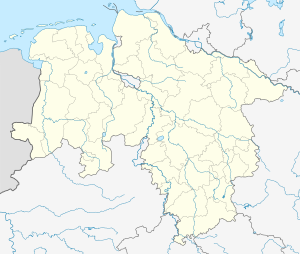Wiesmoor peat power station
| Wiesmoor power plant | |||
|---|---|---|---|
| The Wiesmoor peat power station (1910) | |||
| location | |||
|
|
|||
| Coordinates | 53 ° 24 '46 " N , 7 ° 44' 0" E | ||
| country | Lower Saxony | ||
| Data | |||
| Primary energy | Peat , gas | ||
| owner | Nordwestdeutsche Kraftwerke AG | ||
| operator | Nordwestdeutsche Kraftwerke AG | ||
| Start of operations | 1909 (peat), 1965 (gas) | ||
| Shutdown | 1964 (peat), 1995 (gas) | ||
| Firing | Grate firing | ||
The Wiesmoor peat power plant is a former peat power plant in Wiesmoor , East Frisia . The construction of the power station was initiated by the privy councilor Dr. Ramm been driven. The industrial abortion had just been developed and he wanted to give the peatland colonization new impulses and therefore got in touch with Werner von Siemens, who was developing coal- fired power generation . This is how the peat power plant was designed. It was one of the first steam turbine power plants in northern Germany. The state was responsible for delivering the peat and Siemens-Elektro-Betriebe (SEB) for electricity generation, from 1926 until the demolition in 1965 the Nordwestdeutsche Kraftwerke AG .
First of all, two problems had to be solved: the first was to find a stable underground and the second was access to service water. In order to solve the second problem, a connecting canal from the Ems-Jade Canal was started in 1906 near Marcardsmoor . The Nordgeorgsfehnkanal was completed in 1922. At the intersection between the canal and the Friedeburg - Strackholt road (today: Bundesstrasse 436 ), the power plant was also built. Construction began in 1907 and in 1909 the plant went into operation with three systems and 3240 kW. By 1921 it was expanded to seven machines and 16 MW. Coal soon also had to be delivered via the canal to meet rising demand. The SEB took over the power station completely in 1921 because the state was unable to continue delivering peat. Coal firing was promptly given up again and the power station completely converted to peat, in 1925 the renovations were completed. The plant now mined 120,000 tons of peat (previously: 40,000) and now required 1.2 kg / kWh instead of the previous 4 kg / kWh. In 1926 the plant was sold to Nordwestdeutsche Kraftwerke AG. From 1942 to 1944 the plant was modernized and was able to double its electricity production. After the Second World War, electricity production became more and more unprofitable as the moorland became smaller and smaller. This led to the factory being closed and demolished in 1965. The 11,000 m² Jan Hinrichs Park is now located on the site (Jan Hinrichs had been the director of the peat power plant since 1921).
The plant was replaced by a gas turbine power plant in 1966. It had about twice the capacity, but its operation ended in 1995. On the site of the former power plant in the center of Wiesmoor there are today the Sparkasse Aurich-Norden and an office building owned by BDA Immobilien GbR with approx. 2,700 m² of usable space, in which also houses the town hall of the city.
Gardening
In 1925, a greenhouse plantation, the Wiesmoor nursery , was built next to the power plant, which was supplied with waste heat from the power plant. Mainly cucumbers and tomatoes were grown in the plant. The plant is operated by the NWK subsidiary Wiesmoor-Gärtnerei-GmbH (today: Wiesmoor-Gärtnerei und Baumschule GmbH ).

